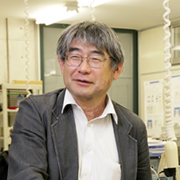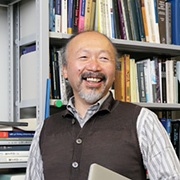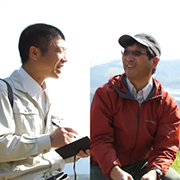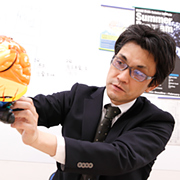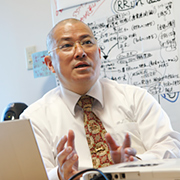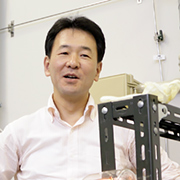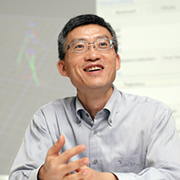Professor Koichi Oka, School of Systems Engineering
For quite some time, there have been more and more mobile probes sending rovers to the moon and planets of the solar system. Since the surface of the moon and some planets is covered with fine sand, the ground is often soft, and various irregular features such as steep slopes and rocks of a variety of sizes make the terrain uneven. Once a rover gets stuck in such terrain, it is difficult to get moving again, so high mobility performance is needed in probe rovers. Until recently, rover suspension has been only a passive structure with weight and electric power supply as the main design considerations. However, new technology advances have enabled research towards a dynamic rover suspension structure suitable even in the space environment. In his research, Professor Oka has conceived of two indicators, ‘surface adhesiveness’ and ‘stability without toppling,’ that can enhance travelling performance on uneven terrain. By installing a weight, capable of motion in two dimensions, on the upper part of a vehicle, Prof. Oka has moved development closer to achieving new rovers with those two capabilities. After repeated experiments, it has been verified that by varying the rover's center of gravity according to the degree of slope, (a) the normal components of reaction of the wheels of a rover can be made uniform and (b) stability can be enhanced by varying the toppling limit angle to increase with pitch direction. In short, it has been demonstrated that moving the center of gravity is an effective means for improving travelling performance. In the future, further research will be aimed at the development of an “active controller’ which can optimally control rover movement so as to circumvent or overcome obstacles on the ground.
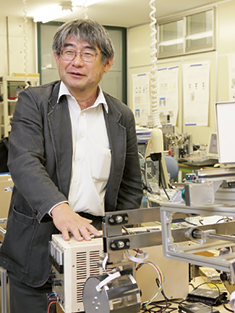
Professor Koichi Oka, School of Systems Engineering
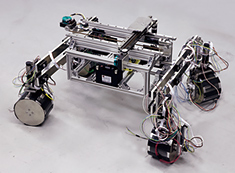
A rover consists of a traveling wheeled chassis and a moveable center of gravity component. The ground load of each wheel can be varied easily by altering the center of gravity.
Taksu Cheon, Professor, School of Environmental Science and Engineering
Quantum graph theory is theory for the control of the movement of quantum particles in a structure like a graph connecting multiple one-dimensional straight lines at a contact point. If we design various systems virtually, every possible phenomenon occurring at the contact point can be analyzed.
Due to the development of nanotechnology, the quantum graph, which deals with microscopic phenomena, has begun to attract attention as a theoretical model for quantum single electron devices at nanoscale. The quantum graph is expected to find various applications, including 1) new functional devices such as a single electron transistor which can be operated with just one electron; 2) nanowire, for example carbon nanotube, and 3) edge current for superconductors. It can be said that time is ripe for the emergence of quantum graph theory as a general framework for theoretical technology for the control of the movement of a single quantum; the time is indeed ripe, since the theoretical technology has already been developed.
Prof. Cheon’s research so far has revealed an extraordinary phenomenon which has not been seen in regular quantum mechanics, hidden at the contact point in quantum graph. In addition, Prof. Cheon has contrived a controllable model by applying external voltage as a spectral filter by means of quantum graph. This has opened up a new direction for research on controllable quantum spectral filter as a model for highly feasible quantum transistor devices. Further thrilling developments in this field are anticipated.
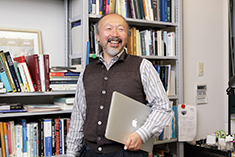
Taksu Cheon, Professor, School of Environmental Science and Engineering
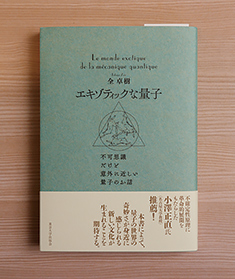
A book authored by Prof. Cheon, explaining the concept of quantum mechanics in an easy-to-understand manner.
Masataka Takagi, Professor, School of Systems Engineering
Takashi Watanabe, Visiting Professor, School of Systems Engineering
Prof. Takagi, a specialist in remote sensing, and Prof. Watanabe, who has long been engaged in systematic botany and pharmacology, have worked in collaboration to develop Lupines, a platform combining a geographic information system and a botanical data system, to support the utilization of regional resources. Now Lupines has been released and is in use. With this system as a base, new stereoscopic low altitude aerial photograph image data can be combined with ordinary satellite data and ground survey data, in order to establish a model for minute assessment and estimation of the potential volume of forest and useful plants. In one area of Shikoku's Sukumo City, where timber is being collected for use in a biomass thermal power plant under construction, the team is performing spatial analysis by calibrating three layers of measurement data to create a GIS assessment model for utilization of forest resources. In addition, they conducted a survey of the natural habitat of 5 kinds of useful plants. The results are expected to contribute to the advancement of industry in the whole of Shikoku, especially in Kochi Prefecture. By GIS prediction of suitable places for natural habitat, the team will make an estimation model of the potential amount of biomass so as to generate fundamental data for the industrial utilization of useful plants. Combining the utilization of forest biomass for fuel and the production of useful plants in suitable locations on the forest floor in the intervals of the cycle between afforestation and harvesting supports the creation of an energy industry which places no burden on the global environment and the construction of a model for the management of a sustainable environment.
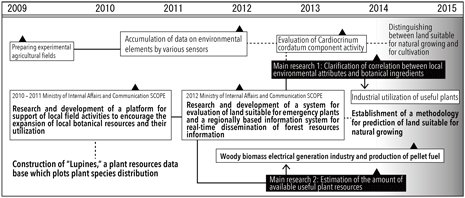
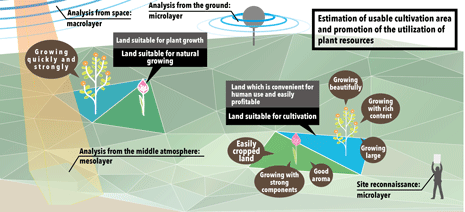
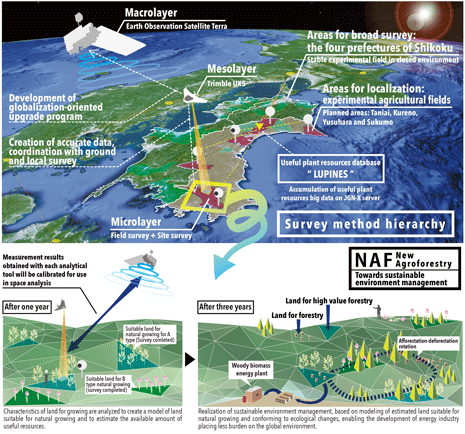
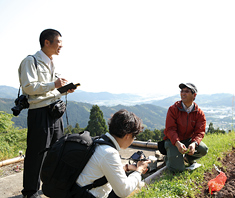
Masataka Takagi, Professor, School of Systems Engineering
Takashi Watanabe, Visiting Professor, School of Systems Engineering
Kiyoshi Nakahara, Professor, School of Information/Research Center for Brain Communication
Associative memories, which create relations between multiple different stimuli or events, are stored in the temporal lobe. However, the brain activity patterns invoked by associative memories are not clearly understood. Prof. Nakahara has discovered through experiments with monkeys that memories connected as a pair are encoded as similarities of brain activity patterns. He is aiming to extend this research by conducting similar experiments with humans: human subjects will be asked to study pairs of figures to form associated memories, and their brain activity patterns will be analyzed by fMRI while they try to recollect the pairs of figures. Then by decoding the brain information, it will be possible to determine whether or not the brain activity patterns resulting when the subject sees one figure of the memorized pair also occur when the subject sees the other figure of the pair. If the memorized content of human brain activity patterns can be decoded in this experiment, the result would be a world-class breakthrough.
Another study is under way to determine if memory function is enhanced by giving the brain alternating current stimulation of a certain frequency (transcranial alternating current stimulation, or tACS). The outcomes of this research are expected to find application in treatments for memory disorders.
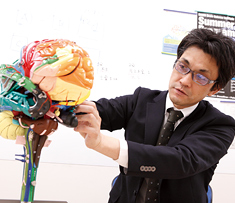
Kiyoshi Nakahara, Professor, School of Information/Research Center for Brain Communication
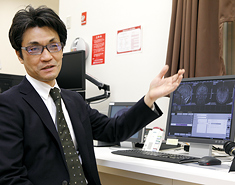
Seigo NASU, Dr. Eng., Professor, School of Economics & Management
According to the 4th IPCC evaluation report, the degrees of drought and heavy rain are dramatically increasing due to climate change. In Japan, the Yoshino River basin in Shikoku Island is also facing severe drought and flood disaster problems. However, the shared information regarding climate change impact and adaptation effect is not effectively prepared, by either scientists or by the government.
In order to understand quantitatively the impacts of these problems on society, the economy, and our lifestyle, we developed an inter-disciplinary integrated model, “End to End Model,” that consists of a scientific climate change model, a hydrological model to predict water resources and their fluctuation, and a social and economic impact evaluation model.
Sharing the information produced by the “End to End Model” allows regional stakeholders to form an agreement on regional policy. We also developed a web-based simulation system which can be used by local government officials to simulate multiple adaptations, both in various combinations and in various orders of deployment.
We obtained two major results. Climate change is a global phenomenon, but its impact is quite different from region to region as a result of local characteristics. Simulation with combined cases of climate change effect and socio-economic scenarios give rather large difference among cities, so adaptation policy must be conducted by each local government, based on local conditions.
Our next research target is to support local governments as they work to create regional adaptation policy regionally using scientific results.
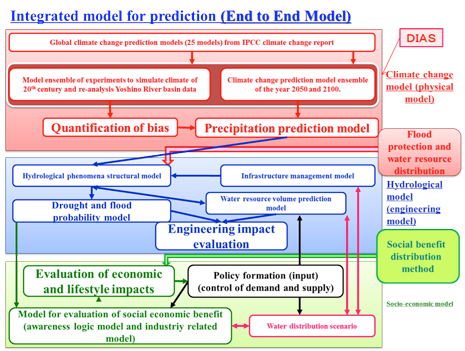
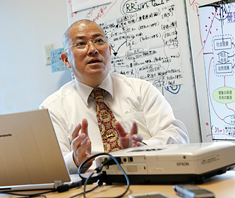
Seigo NASU, Dr. Eng., Professor, School of Economics & Management
Professor Akimitsu Hatta, School of Systems Engineering
Atmospheric pressure plasma and atmospheric pressure plasma jet technology have had a significant impact on the medical and life science fields: they point to the possibility of a wide range of applications in various advanced medical treatments, including drug delivery and gene transfer, far beyond the previously imagined limit of industrial applications such as surface treatment. Prof. Hatta, in collaboration with Kochi Medical School, has been conducting surveys and joint experimentation with domestic and international researchers towards possible plasma medical treatments, to verify that cancer cells can be destroyed selectively.
Currently Prof. Hatta, working with post-doctoral researcher Jun-Seok Oh, is engaged in replicative experiments in a precisely controlled environment in order to understand the impact of radiating plasma on cancer cells and the mechanism of that effect. When a plasma jet of helium gas is used to radiate water and culture fluid, the oxygen active seeds and nitrogen oxide active seeds generated in that fluid can be measured quantitatively using ultraviolet absorption spectroscopy. It is essential to control the environment precisely, since radiation effectiveness is affected by many factors, particularly because it is not easy to control the environment precisely, as the components of the atmosphere are influenced by airflow factors including temperature, humidity and air conditioning. The accumulated data, with high potential for medical applications, along with the results of Kochi Medical School's work to verify the effectiveness of plasma treatment of cancer cells, are expected to lead to the development of new medical treatments.
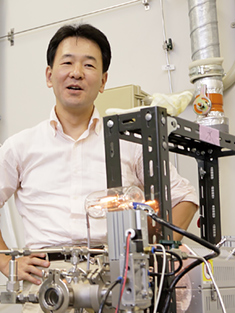
Professor Akimitsu Hatta, School of Systems Engineering
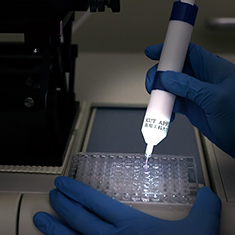
Plasma jet radiation experiment.
Xiangshi Ren, Professor, Center for Human-Engaged Computing & School of Information
With the ongoing development of human interface technology as a core technology of the rapidly spreading smart phones and tablet PCs, some obstacles to ideal design have arisen, for example complexity of operation. Prof. Ren has been working towards the development of a new operational technology based on natural human motions such as body and hand gestures, aiming at the realization of computer technology that is universally usable (including by children, the elderly, and the handicapped). By observing human motion using multiple cameras, it is possible to analyze the difference between movements of subjects who vary in parameters such as age and handicap. Prof. Ren’s intends to apply the findings of this research to the creation of a gesture-input system easily operable by visually impaired persons who have difficulty operating ordinary touch panels. Furthermore, aiding a novel haptic device, Prof. Ren’s team aims at the practical application of a large wall-mounted display to enable people to, for example, more readily obtain timetable information at stations.
Although touch input by finger on a touch device is a variation of stroke gesture with a pen, the practicality of touch applications has not yet been verified: to date no study has compared pen and finger input. In that light Prof. Ren has directed studies of various characteristics of stroke gestures by pen and by finger, leading to a useful characterization of the difference between them. Results indicate that pen and finger gestures were different in features such as gesture size ratio and similar in features such as indicative angle difference. The resulting insights enable the realization of natural and effective gesture input by finger and the creation of useful guidelines for improving touch panel operations.
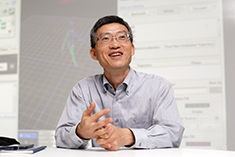
Xiangshi Ren, Professor, Center for Human-Engaged Computing & School of Information
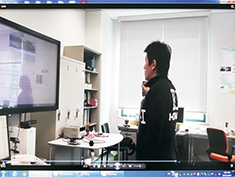
A movement by a visually impaired person trying to access a train timetable is being verified. The sensor detects the movements and then outputs the desired information by means of vibration feedback.
















